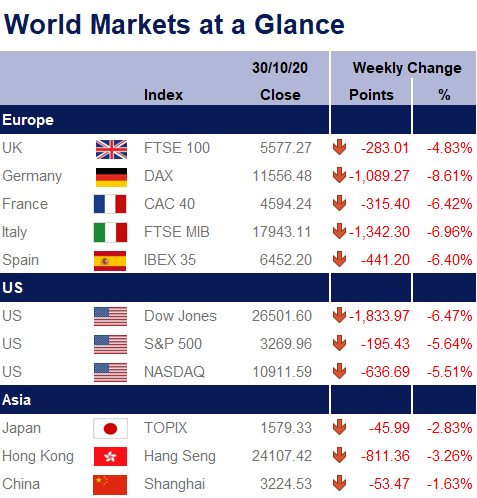In a week that has been littered with pockets of volatility, the markets closed the weekly session lower. Whilst it is difficult to deny that an element of this volatility was driven by the increase in Coronavirus lockdown measures that have not only seen varying levels of national lockdowns announced in countries such as France and Germany, but also an increase in local lockdowns within the UK (and speculation of a national lockdown). The market is now beginning to look through some of the impacts of the pandemic. As such, the levels of volatility we saw last week were largely attributable to not only the uncertainty surrounding the up and coming US election, that is merely days away (3rd November), but also to expectations surrounding some key central banks such as the ECB (European Central Bank) and the BoJ (Bank of Japan), as well as ongoing Brexit negotiations and the release of some elements of the new Chinese 5 year plan.
With the above in mind, whilst the pandemic is continuing to be one of the most devastating periods in many of our lifetimes from a social perspective, from a market perspective it is proving to have an element of transience to it as companies have largely adapted to the current climate. We can see that since the market trough back in March, we have seen a largely v Shape (or Nike Swoosh shape) recovery. The recovery has not been without some pockets of volatility and this week has factored in some of the most influential periods of the year, leaving us largely positive on markets going forward.
In the US, whilst the election is now in full swing, with many Americans having already voted, this week saw a 9 point lead (an average of multiple polls) of Democratic candidate, Joe Biden over Republican, Donald Trump, with Biden taking a significant lead in the two swing states of Michigan and Wisconsin, whilst also appearing to take a slender lead in the typically Republican state of Arizona. All of this being said, whilst it appears that Biden is set to win the election, and even though this is injecting an air of uncertainty into the markets, this volatility is likely to be short lived. As, whilst the Democrats and Republicans are like chalk and cheese, both have made it clear that there are two immediate factors that need addressing whoever wins the house and/or the senate… Global Trade and of course the ongoing requirement for Covid aid. As such, despite them taking different approaches to both, it becomes largely irrelevant who wins the election in terms of market impact over the short to medium term, allowing corporates to look through any uncertainty, allowing for investors to take advantage of the short term noise and attractive valuations.
Elsewhere we saw the BoJ and ECB both conduct their respective policy meetings, with policy broadly remaining unchanged. Haruhiko Kuroda, head of the BoJ, cut growth forecasts for the Japanese economy by 0.8% in 2020 fiscal year but predicted a strong economic rebound of 3.6% in the 2021 fiscal year. Head of the ECB, Christine Lagarde, took a similar approach, maintaining their September predictions of an 8% contraction in Eurozone GDP for 2020, followed by a rebound of 5% in 2021. She followed up by stating that this data would be reassessed in December, whilst also siting that The Pandemic Emergency Purchase Programme (PEPP) could see a boost at the same time. European markets were buoyed by Lagarde’s statements in the press conference, with a weighted expectation of a further €500 billion to be added to the existing PEPP level of €1.35 trillion.
On Thursday China released details of its 5 year plan (the 14th of its kind). It sited quality growth on a par with moderately developed countries by 2035 as a key target, as well as a focus on innovation by heavier investment in research and development. Arguably the most notable element was its plan to further open up its economy to overseas competition, which is in line with Chinese President Xi’s comments that China must actively cooperate with all countries. This is a huge boon for global economies going forward, not only allowing many more corporates access to a population of approximately 1.4 billion, but also alleviating some of the stresses and strains that US trade relations have put on global markets in recent years.
In terms of data towards the end of the week, we saw the Japanese jobless rate remain unchanged at 3%, with the job to applicant ratio further declining to 1.03. US Initial jobless claims came in lower than expected and prior at 751k, with continuing claims also beating expectation and prior at 7.76m. This positive US jobs data was bolstered by annualised GDP increasing by a massive 33.1% (albeit from a low base).
Whilst there are some key data points out next week, such as US and Chinese manufacturing PMI’s, UK and Euro Area Services PMI’s, US unemployment, as well as policy meetings for the US Federal Reserve and the Bank of England, it is likely that extreme short term market sentiment will be focussed on Tuesday’s US Presidential Election.
Jonathan Wiseman, Fund Manager


